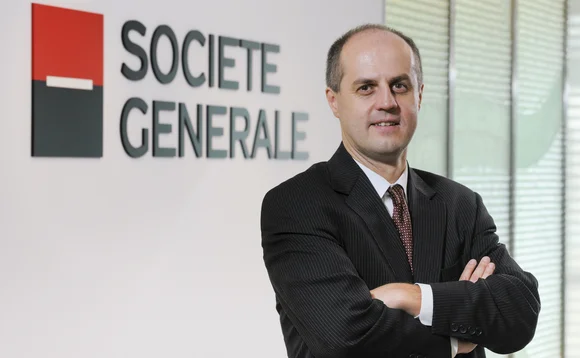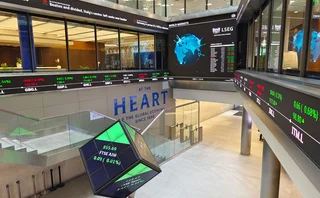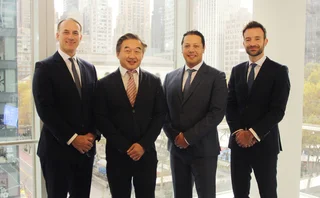
ESG provider of the year: Societe Generale
Asia Risk Awards 2020

Common misconceptions about cost and performance significantly impede the distribution of instruments that invest with a positive cause among banks in Asia. This is why Societe Generale has embarked on a journey to improve that awareness, through client outreach and the introduction of simple products that are appropriate to the market.
ESG – environmental, social and corporate governance – still remains a nascent area in Asia, and investors are typically reluctant to construct a new portfolio according to ESG standards. The French bank, which is known for its structured investment solutions, has introduced a slew of products to mitigate investors’ concerns over cost and performance.
In 2019, SG introduced an ESG-friendly overlay, whereby investors can participate in projects with a positive cause while sticking to their existing strategy, and with no additional transaction costs.

The product is Positive Impact Note, where SG makes the commitment to hold in its balance sheet an amount of ESG-friendly projects (which have been audited as ‘Positive Impact’) equivalent to 100% of the note’s proceeds. The pool of underlying projects are sourced globally – an ultra-high-speed broadband network project in Alsace, an automated metro line in Milan, a hydroelectric power plant in Indonesia and global wind farms, to name but a few – but the note issuance is in Asia.
Volume has exceeded €110 million ($130 million) so far, mostly in Japan, though recently clients in Hong Kong and Singapore have also started subscribing.
“Our strategy to ESG investing leverages SG’s experience in Europe, which entails concrete and interactive solutions that investors can implement right away,” says Inhwan Oh, head of global market sales for Asia-Pacific.
Doing good
Emphasising the educational value of the products and client materials, Oh highlights another product the bank has introduced in order to build awareness of impact investing.
Initially developed for the Singapore market, this product links payouts to a reduction in carbon emissions. The French bank believes the diverging equity performance could buoy investors’ attention on how non-financial factors lift or drag the asset prices over the medium term.
“This product is designed for investors who believe that carbon-neutral or carbon-negative companies will outperform and diverge from the CO2 losers,” says Oh. “In our research, the carbon footprint can be seen as a driver of risk premia and thus performance, more than to only convey an ethical image in a portfolio.”
This product is designed for investors who believe that carbon-neutral or carbon-negative companies will outperform and diverge from the CO2 losers
Inhwan Oh, Societe Generale
In one particular trade, the client was supported by historical data back-testing, measuring the economic relevance between carbon emission and the stock market.
The bank compiled a basket of 10 stocks. On the one side were five companies emitting a high level of carbon, such as airlines and miners of non-renewables, while on the other were another five companies categorised as carbon-neutral or carbon-negative, such as tech and automation companies.
This dispersion trade has been particularly popular during the elevated volatility that markets have seen recently, since the returns of the non-directional product increase as the underlying baskets of stocks diverge.
The roadmap towards clean energy
In mid-2020, SG reaffirmed its intention to pull out completely of the thermal coal sector worldwide, and said it is curtailing support for companies engaged in the sector.
In Asia, financing renewable infrastructures and encouraging a higher adoption of alternative energy sources have been among the bank’s key focuses in ESG. In September 2019, SG committed to accelerate the development of energy transition by promising to raise more than €120 billion by 2023, including €100 billion for green bonds and €20 billion for renewable energy.
Daniel Mallo, head of natural resources and infrastructure for Asia, says that despite a nascent trend of sustainable investing, some clean energy sectors have started to take hold in Asia.
“What we find is that Asia has experienced an acceleration in energy transition, albeit starting from a lower base, over the last couple of years. In particular the offshore wind power sector is now on the verge of becoming a regional asset class, rapidly expanding across north Asia and starting to assess potential in South-east and South Asia,” he says.
Mallo says similar projects were non-existent in most parts of Asia two years ago. Today, more than 1,500 megawatts of offshore wind power capacity is being developed in Taiwan, for instance.
“In my view, from where we were just two or three years ago, the region has gone from almost zero to more than a handful of markets in the region jumping into the offshore wind power asset class, from Taiwan to Japan to South Korea and on to India, South-east Asia and Oceania,” adds Mallo.
One area that Asia is leading the way in is floating solar power, where Mallo says the bank is seeing more activity in this part of the world than anywhere else. A report by the Global Wind Energy Council showed that Asia-Pacific installed 50% of new wind-power complexes globally, with $10 billion capital spent in total. The capital injected into wind projects there is almost double the amount in Europe. Taiwan is a key market for renewable energy initiatives, thanks to both public and private activities.
As part of the broader government plan to transit energy mix, clean energy is expected to take up 20% of total electricity generation by 2025. According to official predictions, a total of 5.5 gigawatts generated by wind farms will contribute to the increase in the use of renewables.
In view of those encouraging fundamentals, SG is actively participating in the new Asian wind-farm asset class and was the first foreign bank to issue Taiwan dollar-denominated green bonds in 2018. It has since facilitated the financing of relevant projects in Taiwan.
Only users who have a paid subscription or are part of a corporate subscription are able to print or copy content.
To access these options, along with all other subscription benefits, please contact info@risk.net or view our subscription options here: http://subscriptions.risk.net/subscribe
You are currently unable to print this content. Please contact info@risk.net to find out more.
You are currently unable to copy this content. Please contact info@risk.net to find out more.
Copyright Infopro Digital Limited. All rights reserved.
As outlined in our terms and conditions, https://www.infopro-digital.com/terms-and-conditions/subscriptions/ (point 2.4), printing is limited to a single copy.
If you would like to purchase additional rights please email info@risk.net
Copyright Infopro Digital Limited. All rights reserved.
You may share this content using our article tools. As outlined in our terms and conditions, https://www.infopro-digital.com/terms-and-conditions/subscriptions/ (clause 2.4), an Authorised User may only make one copy of the materials for their own personal use. You must also comply with the restrictions in clause 2.5.
If you would like to purchase additional rights please email info@risk.net
More on Awards
Clearing house of the year: LCH
Risk Awards 2025: LCH outshines rivals in its commitment to innovation and co-operation with clearing members
Best use of machine learning/AI: CompatibL
CompatibL’s groundbreaking use of LLMs for automated trade entry earned the Best use of machine learning/AI award at the 2025 Risk Markets Technology Awards, redefining speed and reliability in what-if analytics
Markets Technology Awards 2025 winners’ review
Vendors jockeying for position in this year’s MTAs, as banks and regulators take aim at counterparty blind spots
Equity derivatives house of the year: Bank of America
Risk Awards 2025: Bank gains plaudits – and profits – with enhanced product range, including new variants of short-vol structures and equity dispersion
Law firm of the year: Linklaters
Risk Awards 2025: Law firm’s work helped buttress markets for credit derivatives, clearing and digital assets
Derivatives house of the year: UBS
Risk Awards 2025: Mega-merger expected to add $1 billion to markets revenues, via 30 integration projects
Interest rate derivatives house of the year: JP Morgan
Risk Awards 2025: Steepener hedges and Spire novations helped clients navigate shifting rates regime
Currency derivatives house of the year: UBS
Risk Awards 2025: Access to wealth management client base helped Swiss bank to recycle volatility and provide accurate pricing for a range of FX structures







